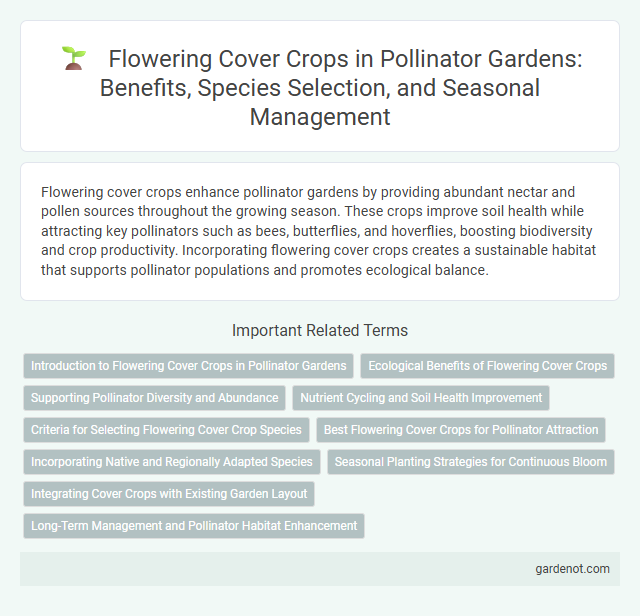Flowering cover crops enhance pollinator gardens by providing abundant nectar and pollen sources throughout the growing season. These crops improve soil health while attracting key pollinators such as bees, butterflies, and hoverflies, boosting biodiversity and crop productivity. Incorporating flowering cover crops creates a sustainable habitat that supports pollinator populations and promotes ecological balance.
Introduction to Flowering Cover Crops in Pollinator Gardens
Flowering cover crops such as clover, buckwheat, and vetch play a vital role in pollinator gardens by providing essential nectar and pollen resources throughout the growing season. These plants enhance soil health through nitrogen fixation, improve soil structure, and reduce erosion, creating a sustainable environment for bees, butterflies, and other pollinators. Integrating flowering cover crops supports biodiversity and fosters a resilient ecosystem that boosts pollinator populations and overall garden productivity.
Ecological Benefits of Flowering Cover Crops
Flowering cover crops enhance soil health by increasing organic matter and promoting beneficial microbial activity, which boosts nutrient cycling and fertility. They provide essential forage and habitat for diverse pollinators such as bees, butterflies, and hoverflies, supporting pollination services crucial for crop productivity. These cover crops also reduce soil erosion and suppress weeds, contributing to sustainable agricultural ecosystems and biodiversity conservation.
Supporting Pollinator Diversity and Abundance
Flowering cover crops such as clover, buckwheat, and phacelia play a crucial role in supporting pollinator diversity and abundance by providing continuous nectar and pollen sources throughout the growing season. These cover crops enhance habitat quality for native bees, butterflies, and other pollinators by improving soil health and offering refuge from pesticides and habitat loss. Integrating diverse flowering cover crops into pollinator gardens boosts ecosystem resilience and promotes sustainable agricultural practices.
Nutrient Cycling and Soil Health Improvement
Flowering cover crops such as clover, buckwheat, and vetch enhance nutrient cycling by fixing nitrogen and improving soil organic matter, promoting overall soil fertility. These plants support beneficial microbial activity, which breaks down organic material and releases essential nutrients for subsequent crops. Incorporating flowering cover crops in pollinator gardens improves soil structure, increases moisture retention, and sustains long-term soil health essential for robust plant growth.
Criteria for Selecting Flowering Cover Crop Species
Selecting flowering cover crop species for pollinator gardens requires prioritizing bloom time diversity to ensure continuous forage throughout the growing season. Species with native origin, high nectar and pollen production, and adaptability to local soil and climate conditions effectively support diverse pollinator populations. Consideration of plant height and growth habit also optimizes habitat structure for pollinator nesting and shelter.
Best Flowering Cover Crops for Pollinator Attraction
Buckwheat, crimson clover, and phacelia are among the best flowering cover crops for pollinator attraction, providing abundant nectar and pollen sources. These cover crops bloom profusely, supporting diverse pollinator species such as bees, butterflies, and hoverflies. Integrating them into pollinator gardens enhances biodiversity while improving soil health through nitrogen fixation and organic matter addition.
Incorporating Native and Regionally Adapted Species
Flowering cover crops such as native clover, buckwheat, and purple prairie clover provide essential nectar and pollen resources, supporting local pollinator populations while improving soil health. Incorporating regionally adapted species ensures resilience to local climate and pests, enhancing garden sustainability and biodiversity. These native flowering cover crops create habitat connectivity, fostering pollinator diversity and ecosystem stability in pollinator gardens.
Seasonal Planting Strategies for Continuous Bloom
Flowering cover crops such as clover, buckwheat, and phacelia play a vital role in pollinator gardens by providing continuous bloom throughout the growing season. Seasonal planting strategies involve staggering sowing times and selecting crop varieties with overlapping flowering periods to ensure a steady nectar supply for bees, butterflies, and other pollinators. This approach not only supports pollinator health but also improves soil fertility and biodiversity within the garden ecosystem.
Integrating Cover Crops with Existing Garden Layout
Integrating flowering cover crops such as crimson clover or phacelia into an existing pollinator garden enhances biodiversity and provides essential nectar and pollen resources throughout the growing season. Strategic placement of these cover crops between perennial flower beds or in unused garden spaces supports soil health by fixing nitrogen and improving soil structure. This approach promotes a continuous bloom cycle, attracting diverse pollinator species and strengthening the overall ecosystem resilience.
Long-Term Management and Pollinator Habitat Enhancement
Flowering cover crops such as clover, phacelia, and buckwheat provide continuous nectar sources that support pollinator populations throughout the growing season, enhancing habitat quality. Incorporating these cover crops in crop rotations improves soil health by fixing nitrogen and increasing organic matter, promoting sustainable long-term garden management. Strategic planting and timely mowing ensure flowering cover crops maximize forage availability while supporting diverse pollinator species in pollinator gardens.
Flowering cover crop Infographic

 gardenot.com
gardenot.com